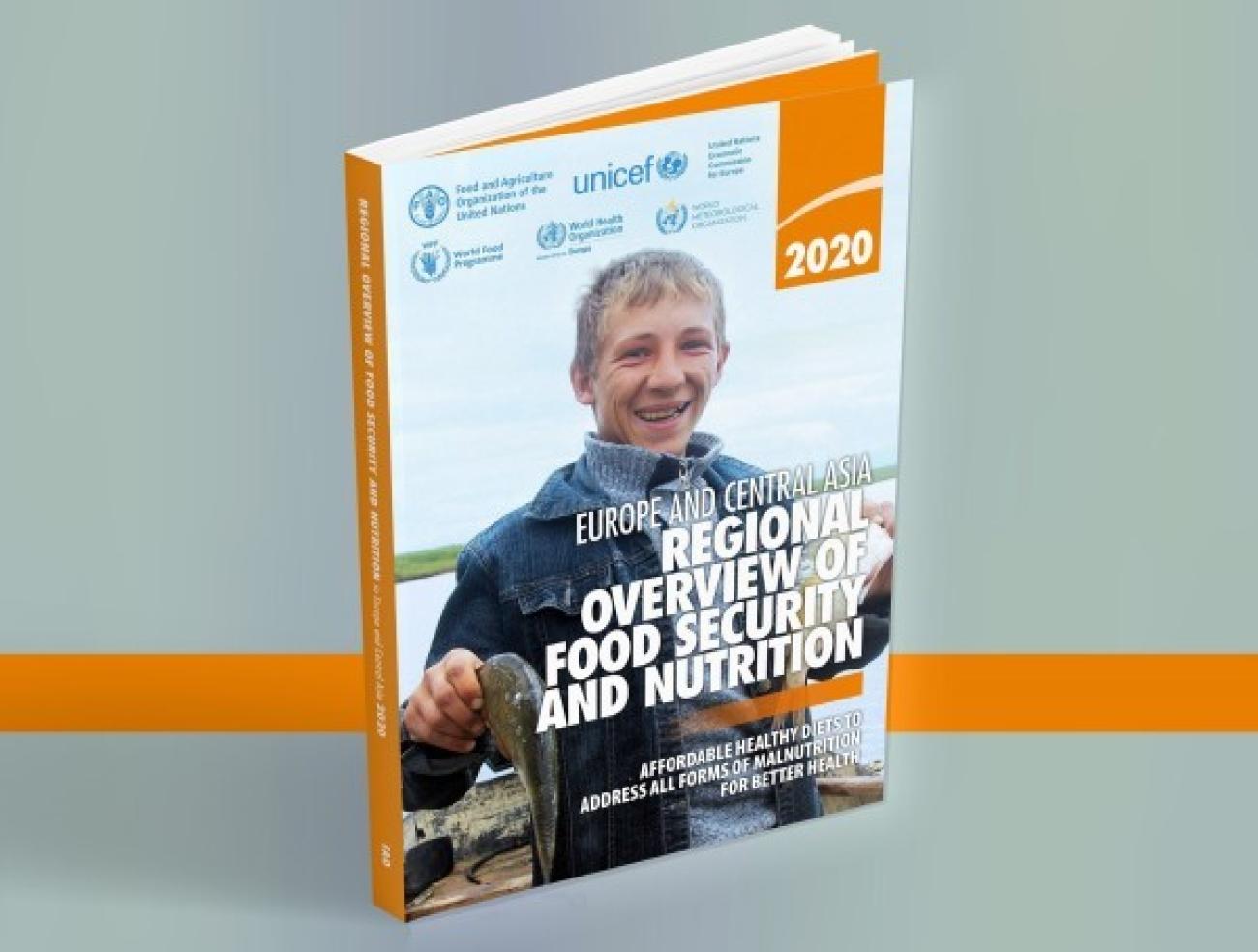The FAO-led 2020 food security and nutrition report for Europe and Central Asia elaborates on the costs of a healthy diet

Affordable healthy diets can trigger positive development in nutrition, sustainability
12 May 2021, Budapest, Hungary – Although severe hunger has not been a major issue in Europe and Central Asia in the past 20 years, the region is in part facing an increase of moderate food insecurity – understood as irregular access to nutritious and sufficient food –, while also dealing with the widespread rapid growth of obesity, challenging its ability to achieve food security and improved nutrition, as outlined in the Sustainable Development Goal (SDG) 2.
Lowering the costs of healthy diets can be crucial to achieving better nutrition and sustainability.
According to the Europe and Central Asia Regional Overview of Food Security and Nutrition 2020, the COVID-19 pandemic has posed serious threats to food security and nutrition, especially for low-income and vulnerable populations in the region.
The annual report, produced jointly by FAO, United Nations Economic Commission for Europe (UNECE), United Nations Children's Fund (UNICEF), World Food Programme (WFP), World Health Organization (WHO), and the World Meteorological Organization (WMO), provides a comprehensive analysis of the topic, including all forms of malnutrition, current dietary patterns, and the costs of diets for individuals, society, and the planet.
Of particular concern in Europe and Central Asia overall is the rapidly worsening situation in some countries of Central Asia, the Commonwealth of Independent States and the Caucasus, which is keeping the region as a whole from achieving the 2030 targets of the SDGs on the prevalence of severe and moderate food insecurity.
“The past 12 months have shown that our health and the functioning of our agrifood systems are fundamental – and that more effort is needed,” said Vladimir Rakhmanin, FAO Assistant Director-General and Regional Representative. “We all – including decision makers, the development community, civil society, academia, the private sector and individuals – have to do our part to achieve the Zero Hunger goal, food security and improved nutrition, leave no one behind and promote sustainable agriculture.”
“Reducing hunger and malnutrition calls for a life-cycle approach, with special attention paid to children, adolescent girls, mothers and other vulnerable groups,” said John Aylieff, WFP Regional Director, Asia and the Pacific. “Zero Hunger is not just about having a belly full. It requires us to work across sectors – from agriculture and social protection to education and health – to ensure a healthy, balanced diet that’s also affordable and accessible for all.”
“Depending on their production and location, farmers in the region have been particularly hit by the disruptions caused by the COVID-19 pandemic, in particular in countries with economies in transition,” stressed Olga Algayerova, Under-Secretary-General of the United Nations and UNECE. “I call on governments to deploy adequate financial support to farmers. I also invite them to make full use of the UN trade facilitation and border-crossing procedures to keep borders open to facilitate the flow of goods, in particular essential products such as fresh food.”
Countries are making headway in the eradication of child stunting and wasting and low birth weight, but an opposite tendency is recorded for anaemia and exclusive breastfeeding during the first six months of life. In all countries of the region, gaps exist in the policy framework for the prevention of obesity and iron deficiency anaemia.
“UNICEF acknowledges the important breakthroughs countries have achieved concerning child stunting, wasting and low birth weight. However, without a redoubling of effort, the region will not meet 2025 and 2030 commitments on childhood obesity, anaemia and exclusive breastfeeding,” said Afshan Khan, UNICEF Regional Director for Europe and Central Asia and Special Coordinator for the Refugee and Migrant Response in Europe. “Affordable, healthy diets are the basis of food security and nutrition outcomes, and the impact of the COVID-19 pandemic has increased the vulnerability of children’s nutrition. We have evidence to share with policymakers and food suppliers to take action to improve diets and mobilize health, education and social systems to scale up nutrition results for children.”
The prevalence of overweight and obesity is a major problem, even among children, with alarmingly high rates in most countries of the region. According to the World Health Organization, the prevalence of overweight among children aged 6–9 is the highest in Mediterranean countries.
“People living with obesity have an increased risk for severe COVID-19 outcomes,” said Hans Kluge, WHO Regional Director for Europe. “COVID-19 has also highlighted how fragile food systems can be – and how important it is to ensure that all people, no matter where and how they live, have access to safe, healthy and sustainable food. For the WHO European region, this is vital, given the alarming situation with obesity – a chronic complex disease in itself and a major risk factor for non-communicable diseases in the region.”
Additionally, the region is strongly affected by challenges imposed by the overconsumption of foods high in salt, fat and sugar and the underconsumption of fruits and vegetables. This calls for structural changes in food production and consumption within current food systems. WHO data show that unhealthy diets account for an estimated 86 percent of deaths and 77 percent of the disease burden in the region.
When developing national food security and nutrition strategies, FAO recommends that countries consider the environmental and climate impacts of the reference diet – which is currently not included – and increase education on that.
“The impacts of climate and environmental changes increasingly challenge current governance efforts,” said Milan Dacić, WMO Chief for Europe. “Policies are needed that support sustainable land management, reduce air pollution, ensure the supply of food for vulnerable populations, reduce crop loss and limit greenhouse gas emissions associated with agriculture. World Meteorological Organization activities on long-term monitoring; sharing of data, information and knowledge; and improved context-specific forecasts and analysis are vital support to alleviation of the impacts of climate and environmental changes.”
Fang also pointed at the disadvantageous composition of food available in the markets of Europe and Central Asia. As revealed in the regional overview, the availability of animal-based foods is above the world average, while the consumption of vegetables, pulses and fish is below the world average. Increased attention to a nutrition-sensitive agriculture facilitating healthy diets would be required. The European Green Deal and From Farm to Fork initiatives are policy frameworks that could facilitate change.
“The main conclusion is that despite good progress in diversifying and moving food availability in the right direction, there is a need to reorient food production and trade systems to enable healthy diets,” said Cheng Fang, an FAO economist and the main author of the report. “This may require additional efforts in consumer education and incentives to increase the consumption of fruits and fish, among other foods, to achieve sustainable and healthy nutrition strategies in these countries.”
The costs of healthy diets
Healthy diets are generally expensive, as they cost five times more, on average, than diets that cover only the basic energy needs through a starchy staple, according to the FAO report and based on the analysis of food cost/affordability data from 14 selected countries in Europe and Central Asia.
Cost drivers include trade, public expenditures and investment policies throughout agrifood supply chains. To counter their impacts, FAO and the World Food Programme advocate for nutrition-sensitive investments, targeted interventions and social protection policies and programmes to increase the affordability of healthy diets in a sustainable manner. To this end, the experience of Armenia with nutrition-sensitive social protection measures is presented in the report.
“The benefits of a nutritious diet affect not only individuals, but also the society as a whole,” said Fang, “and the costs of a nutritious diet are also borne by the entire society.”
Overall, the total costs associated with healthy diets are much lower than the costs of current consumption patterns. Were the population to shift to healthy diets, it is projected that direct and indirect health costs would be reduced up to 97 percent and the social cost of greenhouse gas emissions would be reduced by 41–74 percent, according to data from projects in the examined countries. These benefits could potentially increase over time with innovation and the adoption of new technologies involving climate-smart agriculture.
LINKS
Europe and Central Asia Regional Overview of Food Security and Nutrition 2020
Launch of the 2020 Regional Overview of Food Security and Nutrition in Europe and Central Asia
SDG2: Zero Hunger
“The momentum created by the pandemic offers us a chance to rethink our agrifood systems, among other issues, and to set off a transformation for better food and nutrition at less cost to the environment. The UN Food Systems Summit convened this fall by the UN Secretary-General, gives us all an excellent opportunity to address this important issue,” said Rakhmanin.
Written by


